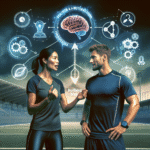
Introduction
In a world dominated by fast-paced life and heightened stress levels, the quest for optimal health has never been more critical. Many seek solutions that not only alleviate symptoms but also cultivate a deeper understanding of their body and mind. This brings us to Real-Time Healing: Understanding the Mechanisms of Biofeedback Therapy—a powerful approach that empowers individuals to take control of their health journey through real-time insights.
Imagine a method that allows you to tune into your body’s signals while actively engaging in your healing process. Biofeedback therapy offers just that, enabling people to improve their physical, emotional, and mental well-being through personalized feedback mechanisms. In this comprehensive article, we will explore the fascinating world of biofeedback therapy, its underlying principles, and how it serves as a vital tool for real-time healing.
What is Biofeedback Therapy?
Definition and Mechanisms
Biofeedback therapy is a non-invasive technique that teaches individuals how to control bodily functions through real-time feedback. It employs various instruments to measure physiological functions, such as heart rate, muscle tension, skin temperature, and brainwave activity. The data collected is presented back to the individual, allowing them to make immediate adjustments to improve their physical or mental state.
How Does Biofeedback Work?
At its core, biofeedback transforms complex physiological data into comprehensible information. For example, sensors can detect an increase in heart rate during stressful situations. The individual, upon seeing this change in real time, can implement relaxation techniques, such as deep breathing, to lower their heart rate. Over time, this practice helps individuals develop better self-regulation skills.
Types of Biofeedback
Different forms of biofeedback cater to various health issues. Understanding these types can help individuals choose the most suited method for their needs.
1. Electromyography (EMG) Biofeedback
EMG tracks muscle tension and activity. It is frequently used to help alleviate chronic pain, muscle disorders, and tension headaches.
Case Study:
A 45-year-old office worker suffering from migraines underwent EMG biofeedback therapy. After several sessions, she reported a substantial decrease in the frequency and intensity of her migraines. Regular monitoring helped her identify muscle tension triggers, ultimately leading to more effective stress management.
2. Thermal Biofeedback
This method measures skin temperature, providing insights into blood flow and stress levels. It is particularly useful for managing anxiety and relaxation training.
Case Study:
A young adult experiencing test anxiety received thermal biofeedback training. By monitoring their finger temperature, they learned to implement techniques that led to a significant reduction in anxiety during exams.
3. Neurofeedback
Neurofeedback uses real-time displays of brain activity to teach self-regulation of brain function. This approach is beneficial for conditions like ADHD, PTSD, and anxiety disorders.
Case Study:
A child diagnosed with ADHD participated in neurofeedback sessions. The intervention helped them improve focus and decrease impulsivity, suggesting a clear link between real-time monitoring and enhanced self-regulation.
4. Heart Rate Variability (HRV) Biofeedback
HRV biofeedback focuses on heart rate patterns. It is particularly used for stress management and emotional regulation.
Case Study:
An athlete seeking to improve performance and reduce anxiety integrated HRV biofeedback into their training. This method helped them manage pre-competition nerves, resulting in enhanced performance outcomes.
The Science Behind Biofeedback: Facilitating Real-Time Healing
A thorough understanding of the physiological mechanisms behind biofeedback therapy underscores its effectiveness.
Understanding Autonomic Nervous System Regulation
Biofeedback primarily operates on the principles of the autonomic nervous system (ANS), which governs involuntary bodily functions. The ANS consists of two branches: the sympathetic (fight-or-flight) and parasympathetic (rest-and-digest) systems.
When faced with stress, the sympathetic system predominates, leading to physiological responses such as increased heart rate and muscle tension. Biofeedback facilitates awareness of this shift, enabling the individual to employ techniques that activate the parasympathetic system, promoting relaxation and healing.
Real-Life Applications of Biofeedback Therapy
Biofeedback therapy finds diverse applications, serving individuals with various health concerns. Here are some notable areas where real-time healing has shown promising results.
1. Chronic Pain Management
One of the most significant applications of biofeedback lies in the management of chronic pain. By monitoring physiological cues, patients learn to regulate their body’s response to pain more effectively.
Case Study:
A patient dealing with fibromyalgia underwent biofeedback therapy and reported a 60% reduction in pain levels. By gaining insight into the muscle tension associated with their pain flare-ups, they could employ relaxation techniques that offered substantial relief.
2. Anxiety and Stress Reduction
Biofeedback is increasingly recognized for its efficacy in reducing anxiety symptoms. By training individuals to control physiological responses, they can better manage stressors in their lives.
Case Study:
A recent study explored the impact of biofeedback on college students dealing with anxiety. The results indicated that participants who engaged in biofeedback sessions experienced decreased anxiety levels and improved coping strategies.
| Study Group | Pre-Therapy Anxiety Scores | Post-Therapy Anxiety Scores |
|---|---|---|
| Control Group | 75 | 70 |
| Biofeedback Group | 76 | 55 |
3. Improving Athletic Performance
Athletes harness biofeedback to fine-tune their mental and physical performance. Techniques such as HRV training allow athletes to achieve peak performance consistency.
Case Study:
A professional swimmer incorporated biofeedback into their training regimen and achieved personal bests in competitions. By using feedback on heart rate and muscle tension, they were able to optimize their training sessions for better outcomes.
The Future of Biofeedback Therapy
As scientific research continues to validate the effectiveness of biofeedback therapy, its popularity is bound to grow. The advent of wearable technologies that allow for at-home biofeedback applications will likely enhance accessibility.
Emerging Technologies
New advancements in technology are paving the way for more innovative and user-friendly biofeedback systems. Wearable devices equipped with sensors that measure various physiological indicators can provide real-time feedback and contribute to self-awareness and healing.
Integration with Other Therapies
The combination of biofeedback with approaches like cognitive-behavioral therapy (CBT) and mindfulness practices is proving to be a robust path to real-time healing. For instance, by integrating biofeedback with CBT, patients can gain insights into their physiological responses during situations that trigger anxiety or distress.
Conclusion
Real-Time Healing: Understanding the Mechanisms of Biofeedback Therapy offers individuals a comprehensive approach to health and wellness. By harnessing the power of real-time feedback, biofeedback therapy empowers individuals to gain insight into their physiological responses, paving the way for self-regulation and improved well-being.
As we advance further into the era of personalized health, biofeedback therapy stands out as an effective tool—a means to not only alleviate symptoms but to understand the underlying mechanisms that contribute to our overall health. By actively participating in the healing process, individuals can achieve a level of wellness that is both profound and sustaining.
FAQs
What conditions can biofeedback therapy treat?
- Biofeedback therapy is effective for various conditions such as chronic pain, anxiety, migraines, and even ADHD.
How long does biofeedback therapy typically take?
- The duration can vary based on individual needs; some may see immediate results, while others may require several sessions.
Is biofeedback therapy safe?
- Yes, biofeedback is a non-invasive and drug-free approach, making it a safe option for most individuals.
Can I practice biofeedback at home?
- Yes, many individuals use wearable technologies that provide biofeedback outside clinical settings, promoting self-care.
- Will biofeedback replace traditional medical treatments?
- Biofeedback is best viewed as a complementary therapy to traditional treatments, enhancing overall wellness and patient empowerment.
By employing biofeedback as a part of a holistic approach to health, individuals can step into the future of wellness with confidence and clarity. Real-time healing is not just a dream; it is a reality made tangible through the understanding of our body’s intricate mechanisms.
















